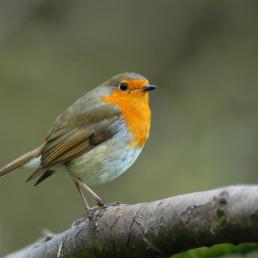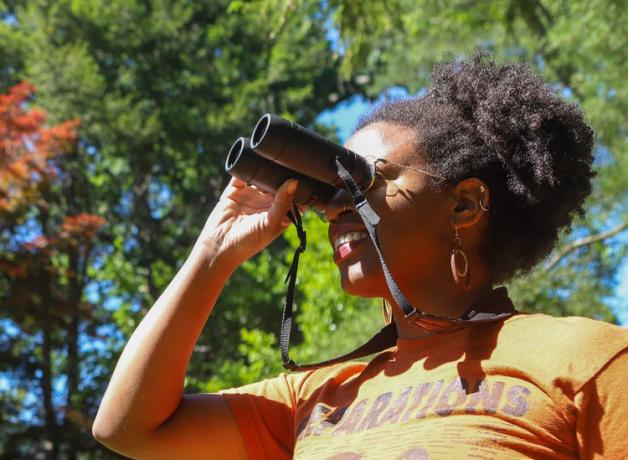

Join BirdNote tomorrow, November 30th!
Illustrator David Sibley and actor H. Jon Benjamin will face off in the bird illustration battle of the century during BirdNote's Year-end Celebration and Auction!
A decent pair of binoculars can considerably enhance your enjoyment of birds. In this episode, Dara Miles Wilson — a naturalist with Montgomery Parks in Maryland — shares a crash course on how to use binoculars.
BirdNote®
Binoculars 101
Written by Dara M. Wilson
This is BirdNote. I’m Dara Miles Wilson, and I’m a naturalist with Montgomery Parks in Maryland.
A decent pair of binoculars can considerably enhance your enjoyment of birds. Since they are an important tool for birdwatching, here is a crash course on how to use binoculars.
[Baltimore Oriole song]
If you’re picking up your binoculars for the first time, adjust your set to ensure the distance between the two barrels lines up with your eyes. The goal is to get a uniform, circular image when looking through the lenses. If you wear glasses, roll the eyecups down for more comfortable viewing.
[Northern Flicker call]
Next, find the diopter adjustment knob located on one of the barrels close to the eyepiece - it’s usually near the right eyecup. Fine-tuning the diopter helps compensate for the differences between your eyes.
[Red-shouldered Hawk call]
Finally, adjust the thumbwheel, also called a focus wheel, in the center of your binoculars. Turning the wheel one way brings closer objects into focus, going the other way focuses on distant objects. A professional trick is to look at the object with the naked eye first, then bring the binoculars up to your eyes instead of scanning for objects through the binoculars. Now, you’re ready to watch the wildlife!
[Bird chorus]
This week is Black Birders Week. To learn how to participate, follow the hashtag Black Birders Week on social media and visit BirdNote dot org.
###
Senior Producer: John Kessler
Producer: Mark Bramhill
Managing Editor: Jazzi Johnson
Managing Producer: Conor Gearin
Content Director: Jonese Franklin
Bird sounds provided by The Macaulay Library of Natural Sounds at the Cornell Lab of Ornithology, Ithaca, New York. Baltimore Oriole ML242872891 recorded by Jay McGowan, Northern Flicker ML224664 recorded by Bob McGuire, Red-shouldered Hawk ML229090 recorded by Bob McGuire, and Environmental ML305942 recorded by Wil Hershberger.
BirdNote’s theme was composed and played by Nancy Rumbel and John Kessler.
© 2023 BirdNote May 2023
Narrator: Dara Miles Wilson
ID# binoculars-01-2023-06-01 binoculars-01
More tips from Dara:
- With binoculars, it's important to pick a pair that’s right for you. Cheap pairs can cost as low as $25, and high end binoculars can cost over $1000. The most important characteristics for a pair of binoculars are its magnification and its aperture, also known as the field of view. For birding, a magnification of 7x or 8x would be perfect, and the aperture should be between 25 and 45. Higher magnification can help you see distant birds such as seabirds better, while lower magnification offers a wider field of view. My binoculars are 10x42. Try different sizes and styles to see what suits you best.
- The diopter adjustment knob helps compensate for any differences between your eyes. Once you find the diopter adjustment knob (usually near the right eyecup), hold your binoculars up to your face and close your eye that isn’t on the same side as the diopter. Raise your binoculars up to your eyes and use your hand to move the diopter adjustment knob until you can see clearly out of your open eye.

